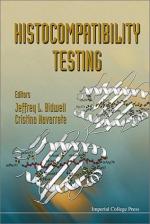|
This section contains 647 words (approx. 3 pages at 300 words per page) |

|
Histocompatibility refers to the means by which a eukaryotic cell can be identified. The phenomenon is the result of the presence of proteins on the surface of cells. These proteins are referred to as histocompatibility molecules. The histocompatibility molecules on the cells of one individual of a species are unique. Thus, if the cell is transplanted into another person, the cell will be recognized by the immune system as being foreign. The histocompatibility molecules act as an antigen in the recipient, and so can also be called a histocompatibility antigen or transplantation antigen. This is the basis of the rejection of transplanted material.
Identical twins have the same histocompatibility molecules on their cells. Thus, tissue can be successfully transplanted from one individual to the other, because the tissue will essentially not be foreign. However, for unrelated individuals, cells will have their own signature chemistry with respect to the...
|
This section contains 647 words (approx. 3 pages at 300 words per page) |

|


